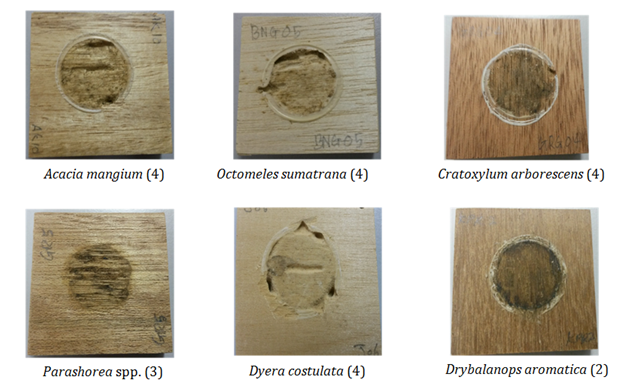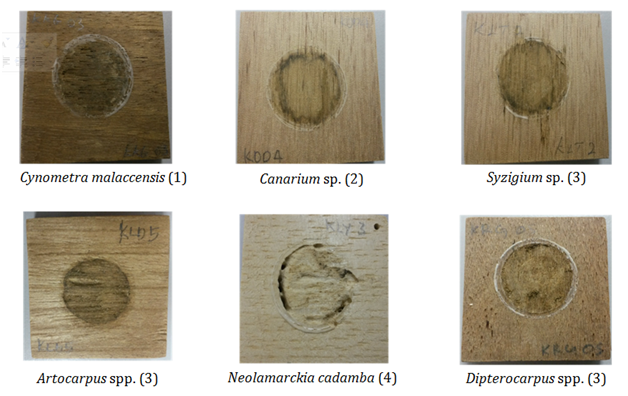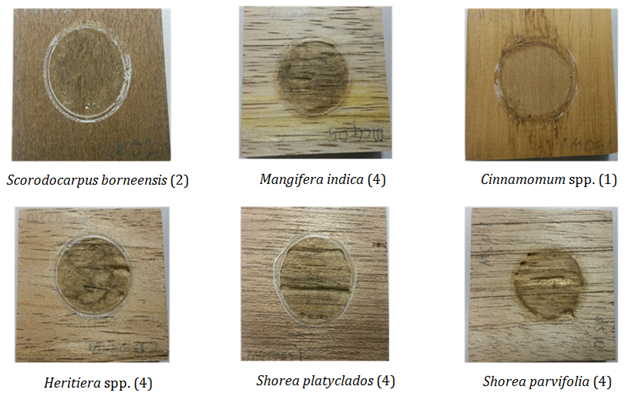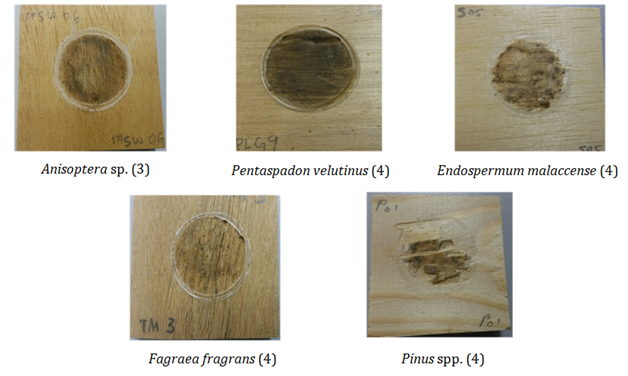eISSN: 2577-8307


Research Article Volume 1 Issue 2
1Forest Research Institute Malaysia (FRIM), Malaysia
2Malaysian Timber Industry Board (MTIB), Wilayah Persekutuan Kuala Lumpur, Malaysia
3Malaysian Wood Industries Association, Wilayah Persekutuan Kuala Lumpur, Malaysia
4Malaysian Timber Council, Wilayah Persekutuan Kuala Lumpur, Malaysia
Correspondence: Roszaini Kadir, Forest Research Institute of Malaysia (FRIM), 52109 Kepong, Selangor Darul Ehsan, Malaysia, Tel 00603-62797410
Received: July 10, 2017 | Published: November 3, 2017
Citation: Roszaini K, Salmiah U, Rahim S, et al. Qualitative and quantitative determination of resistance of twenty two Malaysian commercial timbers through subterranean termite feeding behavior. Forest Res Eng Int J. 2017;1(2):52-60. DOI: 10.15406/freij.2017.01.00008
The durability of wood, or the natural resistance of wood against termites, is an extremely variable property. The durability of 22 Malaysian commercial timber species has been reviewed based on the European Standard 350-1 (1994) (laboratory trials) of the Heartwood of mature timbers harvested from the natural forest. Based on this, the European standard EN118 (2005) was used for termites test. Coptotermes curvignathus was introduced to different wood species in controlled conditions for 8 weeks. The efficacy in wood degradation was calculated based on average of weight loss and visual rating of each timber species. The results showed that 2 timber species fall under durable and 3 species under moderately durable while the other 17 species under susceptible class.
Keywords: deterioration, durability, malaysian timbers, en118, subterranean termitesM
As defined in BS EN 350-1,1 natural durability is ‘the inherent resistance of wood to attack by wood destroying organisms’. Eaton and Hale2 defined natural durability or decay resistance as the ability of the Heartwood of any wood species to resist decay. Normally, natural durability is measured by exposing the wood to biological agents such as termites, beetles, fungi and marine borers (e.g.,3,4 While the natural durability of Heartwood is important for situations either to be used partially or fully exposed to the weather, sapwood is always regarded as having low natural durability (perishable or non-durable) except if treated. Certain types of timber are noted for their marked resistance to deterioration and are commonly used as untreated material. In contrast, non-durable timbers generally require preservative treatment if they are to be used in exposed conditions, adding significantly to their cost.
A number of factors influence the durability of a timber, including wood density, tree age, and growing location. The wood resistance, especially against fungal attack also could be increased by the presence of lignin, which, surrounding the crystalline cellulose and even though only 0.03-0.1% of nitrogen content in the wood, to some extent contributed to the natural resistance of the wood.5 However, the most important factor is the extractives within the wood itself, which are formed after the sapwood is transformed into Heartwood.6 It’s having long been recognized as key features that impart natural durability in the Heartwood of certain wood species.7,8
Preliminary studies have found that Malaysian timbers are categorized as not durable based on graveyard test, but durable when they are determined by EN 350-1.1 Malaysia suffered a loss in terms of price premiums as most Malaysian timbers are placed in Grade 4 and 5 based on earlier studies which indicated that 80% of the wood has been categorized as moderately durable and not durable by the graveyard test. Low natural durability of the wood could shorten the service life of a structure or even lead to structural strength failure, when the surrounding conditions e.g. climate, are stimulating growth of fungi in the wooden members. In that case it is important to know the durability of timber in order to minimize the cost of building constructions. Keeping the durability grades meaningful, it might be necessary to define a laboratory test with regard to insect/termite which could be used to compare the natural durability of wood species relative to each other.
As mentioned by Silva et al.9 one of the most limiting factors for the commercial utilization of wood is because of its low resistance to termites and fungi. This study aims to determine the natural durability of Malaysian timbers upon exposure to damaging agents such as termites as stipulated in EN 350-1.1 A total of twenty two Malaysian timber species has been identified to undergo a stress test (durability) of wood in laboratory condition trials with Pinus sp. include as reference timbers. Subterranean termite; Coptotermes curvignathus which is among the aggressive species in Malaysia will be used.
Raw materials
The wood species used in this study are the most commercial Malaysian wood species which were extracted from the Terengganu forest reserve. Southern yellow pine; Pinus spp. was used as a control block as indicated in European Standard EN118.10 All wood species from basal portion of three trees were cut into wood blocks of the size of (50×50×10mm) (radius x tangential x longitudinal). Relevant wood characteristics of these Malaysian timbers are described in Table 1.
Species |
Local Name |
Basic Density (kgm-3) |
Strength Group |
Sapwood & Heartwood Defined? |
Natural Durability |
Treatability with CCA |
A. mangium |
Akasia (LHW) |
290-580 |
C |
Yes |
ND |
Easy |
O. sumatrana |
Binuang (LHW) |
270-465 kg |
D |
Yes |
ND |
Easy |
C. arborescens |
Geronggang (LHW) |
350-610 |
D |
Yes |
ND |
Easy |
Parashorea spp. |
Gerutu (LHW) |
640-880 |
C |
Yes |
ND |
Difficult |
D. costulata |
Jelutong (LHW) |
420-500 |
D |
No |
ND |
Very easy |
D. aromatica |
Kapur (MHW) |
575-815 |
B |
Yes |
D |
Difficult |
Canarium spp. |
Kedondong (LHW) |
495-980 |
C |
Poor |
ND |
Difficult |
C. malaccencis |
Kekatong (HHW) |
880-1,155 |
A |
Poor |
MD |
Difficult |
Syzigium sp. |
Kelat (MHW) |
495-1,010 |
B |
Poor |
MD |
Difficult |
Artocarpus sp. |
Keledang (MHW) |
500-945 |
B |
Yes |
MD |
Easy |
N. cadamba |
Kelempayan (LHW) |
290-465 |
D |
No |
ND |
Easy |
Dipterocarpus spp. |
Keruing (MHW) |
690-945 |
A&B |
Yes |
MD |
Very easy |
S. borneensis |
Kulim (MHW) |
640-975 |
B |
Yes |
MD |
Easy |
M. indica |
Machang (LHW) |
545-610 |
C |
Poor |
MD |
Very easy |
Cinnamomum spp. |
Medang (LHW) |
350-880 |
C |
Yes |
ND |
Difficult |
Heritiera spp. |
Mengkulang (MHW) |
625-895 |
B |
Yes |
ND |
Easy |
S. platyclados |
Meranti bukit (LHW) |
505-870 |
C |
Poor |
MD |
Easy |
S. parvifolia |
Meranti sarang punai (LHW) |
385-755 |
C |
Yes |
ND |
Easy |
Anisoptera sp. |
Mersawa (LHW) |
515-735 |
C |
No |
MD |
Difficult |
P. velutinus |
Pelong (LHW) |
480-835 |
D |
No |
MD |
Difficult |
E. malaccense |
Sesendok (LHW) |
305-655 |
D |
No |
ND |
Very easy |
F. fragrans |
Tembusu (HHW) |
640-1,075 |
B |
No |
D |
Difficult |
Pinus spp. |
Southern Yellow Pine |
375-585 |
D |
No |
ND |
Easy |
Table 1 Wood characteristic and properties of 22 Malaysian commercial timbers and Pinus spp.14,35-38
Density class is based on strength and durability.36 HHW-heavy hardwood, MHW-medium hardwood, LHW-light hardwood. Durability rating:14 ND-nondurable (<2 years), MD-moderately durable (2-5 years), D-durable (>5 years). CCA treatability:39 Very easy (>320 lit/m3), East (240-320 lit/m3), Difficult (80-160 lit/m3). Heartwood-sapwood boundary: well-defined (yes), poorly defined (poor), heartwood absent (no).
Bioassay test against termites
Ten (10) replicates of wood blocks used for each wood species. Testing method adopted was European Standard EN11810 using Asian subterranean termites (Coptotermes curvignathus Holmgren (Isoptera: Rhinotermitidae) collected from active field colonies at the Forest Research Institute Malaysia (FRIM) campus using a method described before.sup>11
The ground glass end of one tube (110mm length x 25mm width) was attached with non-toxic termite adhesive in the center of each wood block (Figure 1). Some wet sand (1:4 v/v water-sand ratio) was added to each tube, occupying at least two-thirds of the volume of the tube, and 250 termite workers, 5 soldiers and 5 nymphs were distributed. Test assemblies were keeping them in a culturing chamber with air circulation controlled at 22+2°C and 65+5% relative humidity for 8 weeks. Ten Pinus spp. samples were used to check the termite virulence. The tubs were unsealed at the end of the test period and the number of live termite workers, soldiers and nymphs were counted in order to determine the survival rate. Each wood block was also examined and visually rated using a standard rating system10 (Table 2).
Rating |
Description |
0 |
No attack |
1 |
Attempted attack: |
2 |
Slight attack: |
3 |
Average attack: |
4 |
Strong attack: |
Table 2 Visual assessment rating of termite attack according to EN118 (2005).
Statistical analysis
A suitable analysis of variance (ANOVA) was performed with wood consumption, degree of attack and the termite mortality rates resulted from the termite test as variables, in resistance to bio-deterioration.
Wood density
The result of density tests for the twenty two selected wood species shown in Table 3 revealed classification into three density classes: C. malaccensis, S. borneensis, Dipterocarpus spp., D. aromatica, Artocarpus sp., Canarium spp., F. fragrans, S. platyclados, P. velutinus, Syzigium sp. and M. indica were in high density class with values of 988, 925, 880, 799, 735, 733, 722, 717, 676, 641 and 639kg/m-3, respectively; Parashorea spp., A. mangium, Anisoptera sp. and C. arborescens were in the medium density group had 575, 532, 523 and 497kg/m-3, respectively, while Pinus spp., Heritiera spp., S. parvifolia, Cinnamomum spp., D. costulata, N. cadamba and O. sumatrana in the low density group (474, 470, 466, 457, 378, 359 and 267kg/m-3, respectively).
Scientific Name |
Visual Rating |
Durability Class |
A. mangium |
4 |
Susceptible |
O. sumatrana |
4 |
Susceptible |
C. arborescens |
4 |
Susceptible |
Parashoreaspp. |
3 |
Susceptible |
D. costulata |
4 |
Susceptible |
D. aromatica |
2 |
Moderately durable |
Canariumspp. |
2 |
Moderately durable |
C. malaccencis |
1 |
Durable |
Syzigiumsp. |
3 |
Susceptible |
Artocarpussp. |
3 |
Susceptible |
N. cadamba |
4 |
Susceptible |
Dipterocarpusspp. |
3 |
Susceptible |
S. borneensis |
2 |
Moderately durable |
M. indica |
4 |
Susceptible |
Cinnamomumspp. |
1 |
Durable |
Heritieraspp. |
4 |
Susceptible |
S. platyclados |
4 |
Susceptible |
S. parvifolia |
4 |
Susceptible |
Anisoptera sp. |
3 |
Susceptible |
P. velutinus |
4 |
Susceptible |
E. malaccense |
4 |
Susceptible |
F. fragrans |
4 |
Susceptible |
Pinus spp. |
4 |
Susceptible |
Table 3 Visual rating and durability classes of 22 Malaysian timbers and Pinus spp. according to EN118 (2005).
Notes: Mean (+ SD) of 10 replicates for each species. 0 = no attack, 1 = attempted attack, 2 = slight attack, 3 = average attack and 4 = strong attack.
Visual rating
Figure 2 gives the general appearances of twenty two Malaysian timber species specimens after the termite standard test. It is apparent that A. mangium, O. sumatrana, C. arborescens, D. costulata, N. cadamba, M. indica, Heritiera spp., S. platyclados, S. parvifolia, P. velutinus, E. malaccenseand F. fragrans were the species that intensely attacked (visual rating of 4) which classified as susceptible timbers. Another four timber species (Parashorea spp., Syzigium sp., Artocarpus sp. and Anisoptera sp.) also classified as susceptible timbers, but with a visual rating of 3 which means that there is a potential for wood is classified under a durable medium if the age of the tree is older.12 D. aromatica, Canarium spp. and S. borneensis were moderately attacked, while C. malaccencisand Cinnamomum spp. be almost untouched. Pinus spp. proved to be completely susceptible to subterranean termites (all 10 replicates had 4 visual rating after eight weeks exposure, Table 4). The same findings were also observed by Tho13 on plantation-grown exotic softwood (P .caribaea) from Malaysia and Indonesia against C. curvignathus, P. insularis by Mohd Dahlan & Tam14 and P. sylvestris against C. formosanus in the laboratory by Grace et al.15
Scientific Name |
Density Range (kg/m-3) |
Wood Consumption (%) |
Termite Mortality (%) |
A. mangium |
513-561 |
11.71 (0.17)a |
100 |
O. sumatrana |
244-970 |
8.22 (1.35)b |
100 |
C. arborescens |
461-518 |
3.16 (0.19)f |
100 |
Parashoreaspp. |
549-611 |
8.79 (0.79)b |
100 |
D. costulata |
342-439 |
11.17 (1.17)a |
100 |
D. aromatica |
777-830 |
2.42 (0.83)f |
100 |
Canariumspp. |
693-746 |
1.66 (0.34)g |
100 |
C. malaccencis |
978-1008 |
0.47 (0.15)i |
100 |
Syzigiumsp. |
597-667 |
3.51 (1.26)f |
100 |
Artocarpussp. |
727-751 |
6.96 (0.09)d |
100 |
N. cadamba |
350-364 |
9.25 (2.18)bc |
100 |
Dipterocarpus spp. |
763-916 |
8.90 (0.83)b |
100 |
S. borneensis |
915-934 |
0.27 (0.10)j |
100 |
M. indica |
632-646 |
6.54 (0.88)e |
100 |
Cinnamomum spp. |
432-469 |
0.98 (0.41)h |
100 |
Heritiera spp. |
463-484 |
9.44 (0.21)b |
100 |
S. platyclados |
681-758 |
7.47 (0.17)c |
100 |
S. parvifolia |
457-479 |
7.59 (0.67)c |
100 |
Anisoptera sp. |
467-557 |
3.13 (0.73)f |
100 |
P. velutinus |
609-736 |
6.33 (0.31)e |
100 |
E. malaccense |
347-368 |
8.11 (1.60)bc |
100 |
F. fragrans |
700-743 |
4.25 (0.63)f |
100 |
Pinus spp. |
465-504 |
11.38 (0.55)a |
100 |
Table 4 Density and wood consumption of 22 Malaysian timbers and Pinus sp. against C. curvignathus.
Notes: Mean (+ SD) of 10 replicates for each species. Percentage values followed by the same letter are not significantly different in the same group at the 0.05 level of probability.




Weight loss or wood consumption
Generally, C. curvignathus were unable to survive for the full 8 weeks of exposure on all timber tested. However, the woods were damaged before the termites died and the damaged varied considerably among these timber species (Table 4). Analysis of variance also revealed the mean difference was significantly different from one another (F, 7.859; d.f. 3:8:11; P<0.001). The termite choice test showed that among the twenty two wood species tested, A. mangium (11.71%) and D. costulata (11.17%) had higher average wood consumption (>10%) followed by another eleven timber species; Heritiera spp. = 9.44%, N. cadamba= 9.25%, Dipterocarpus spp. = 8.90%, Parashorea spp. = 8.79%, O. sumatrana = 8.22%, E. malaccense = 8.11%, S. parvifolia = 7.59%, S. platyclados = 7.44%, Artocarpus sp. = 6.96%, M. indica = 6.54% and P. velutinus = 6.33%. Nine wood species had less than 5% of weight loss; F. fragrans(4.25%), Syzigium sp. (3.51%), C. arborescens (3.16%), Anisoptera sp. (3.13%), D. aromatica (2.42%), Canarium spp. (1.66%), Cinnamomum spp. (0.98%), C. malaccensis (0.47%) and S. borneensis(0.27%). Pinusspp. control samples were strongly attacked by the termite species with an attack of 4 (visual rating) and 11.38% of weight loss. Thus, it can be deduced that A. mangium and D. costulata constituted the termite’s first and second choices, respectively, while C. malaccensis and S. borneensiswere not preferred (distasteful) by the termites since it was left alone by the termites after an exploratory nibbling etched the wood surface damaged during the 8 weeks exposure. On the other hand, Tamashiro et al.16 stated that weight loss or wood consumption less than 3% would be considered as cosmetic damage which unlikely to create a structural hazard, but additional field evaluations are needed to determine the treatment requirements for timbers. Meanwhile, the first third teen timber species were easily degraded despite the toxicity of some of the resinous extractives against termites,15 the content of which may be insufficient to override the presence of feeding stimulant chemicals in the wood.17 Along with wood extractive, chemical components such as cellulose, lignin and total phenolic content of wood showed influence on the rate of degradation.18 The higher cellulose content, the less resistance to termite attacked19 and the higher lignin and total phenolic content, the more resistance of the wood against termite attack.20
On the other hand, C. malaccensis and Cinnamomum spp. have proved in this test to be highly resistant against C. curvignathus although these two species were found to be susceptible using other standard methods.21,22 Meanwhile, these termites are fond to A. mangium, D. costulata and Pinus spp. based on the high percentage of wood consumption (more than 10%) (11.71%, 11.17% and 11.38%, respectively) with all visual rating are 4. Resistance situation can be meaning that the death of termites was caused by starvation or a volatile substance in the wood while susceptible means no repellent or insufficient repellent to prevent substantial feeding for23 but then, different feeding on different timber species may be due to some differences in chemical composition. For example, a higher quantity of carbohydrates (especially starch content) can make the timbers relatively more susceptible to insect attack.24-26
In the case of C. arborescens, D. aromatic, Canarium spp., Syzigium sp., Anisoptera sp. and F. fragrans that fell under moderately durable and susceptible, but with a lower percentage of wood consumption (1.66% to 4.25%) could be due to the unequally distributed of resistant components present in the part of the plant and there is a need to further investigate the nature of the compounds having anti-termitic properties within these woods. As mentioned by Aihetasham & Iqbal,27 the occurrence of organic chemicals such as phenol, quinines, terpenoids and high concentration of lignin may also affect the areas where feeding takes place.
Termite mortality
Interestingly, the standard test revealed that the termite survival rate is not necessarily related to the durability of the wood species due to the same (100%) average percentage of termite death was observed in all test containers. From this, it might be inferred that although C. malaccensis and Cinnamomum spp. be classified as durable against termites, it can be attacked. In fact, both the termite standard and choice tests showed signs of slight attacks. This confirmed the assertion that no wood is completely immune from the attack of termites, only the degree of resistance is varies.28,29
Correlation between wood density and wood consumption
Even though past studies30 that densities influence the termite’s ability to fragment the wood mechanically with its mandibles,Figure 3, show that there was a poor or weak correlation (R2=0.322) between density and wood consumption which revealing that with the increasing of wood density values, it is not sure that the wood consumption will decrease. Same studies done by Roszaini and Hale (2012) on 12 Malaysian commercial wood species also found the similar trend even though they used other standard methods, ASTM D3345-74 (1988). Peralta et al.31 on their study under field conditions also did not find a strong correlation between wood density and termite resistance of different forest species. So the use of density factor alone is not sufficient to determine the durability of Malaysia timber which means that density alone cannot confer durability of timber. Other factors such as the presence of toxic extractives should be taken into consideration32because in no-choice laboratories tests, where termites have to feed on the single wood species presented to them, an accumulation of wood toxins in the confined environment could lead to high mortality.33

Correlation between wood density and visual rating
A linear regression analysis (Figure 4) was performed to establish a correlation between wood density and visual rating for all timber species. As the wood density increased, the visual rating decreased (more resistance). However, results show that there was a weak correlation (R2=0.27) between both variables. On the other hand, study by Owoyemi et al.30 shows a strong and positive correlation (R2=0.83) existed between visual rating and wood density of ten selected Nigerian wood species against Macrotermes sybhylinus (subterranean termites). They concluded that higher wood density species tend to more resistance than medium and low density species.
Correlation between wood consumption and visual rating

The regression equation of correlation analysis between wood consumption and visual rating (samples damage) is plotted in Figure 5. The relationships between both variables for twenty two Malaysian commercial wood species were strong (R2=0.6789). The results show that when the percentage of wood consumption increased, the visual rating increased (less termite resistance). Wong et al.33 reported that there was a tendency towards higher mass loss or reduced termite mortality to correspond with the lower visual ratings (low termite resistance) of 5 lesser-s known species of Malaysian hardwoods: kekatong (Cynometra sp.), kelat (Eugenia spp.), mempening (Lithocarpusspp.), perah (Elateriospermum tapos) and pauh kijang (Irvingia malayana) against Coptotermes curvignathus. In another situation, Lee et al.34 found a strong correlation between these two variables for treated samples [zinc borate (R2=0.94) and calcium borate (R2=0.82)].35-39
The natural durability of 22 Malaysian timber species was evaluated based on laboratory test. A. mangium, O. sumatrana, C. arborescens, D. costulata, N. cadamba, M. indica, Heritiera spp., S. platyclados, S. parvifolia, P. velutinus, E. malaccense, F. fragrans and Pinus spp. be all susceptible to termites. Parashorea spp., Syzigium sp., Artocarpus sp. and Anisoptera sp. be also rating as susceptible but with durability class of 3. D. aromatica, Canarium spp. and S. borneensis be moderately attacked while C. malaccencis and Cinnamomums spp. be durable against termites. Certain treatments are needed to susceptible timber species in order to ensure a longer service life of the wood.
We would like to thank the Forestry Department of Malaysia (JPSM), Malaysian Timber Industry Board (MTIB), Malaysian Timber Council (MTC), Malaysian Wood Industries Association (MWIA), Malaysian Panel-Products Manufacturers' Association (MPMA), Sabah Timber Industries Association (STIA) and Sarawak Timber Industry Development Corporation (STIDC), the departments involved directly or indirectly in this project for their contributions and cooperation in this project. Funding for this research was fully provided by Tabung Pembangunan Industri Kayu Kayan Malaysia (TPIKM).
The author declares that he has no conflict of interests.

©2017 Roszaini, et al. This is an open access article distributed under the terms of the, which permits unrestricted use, distribution, and build upon your work non-commercially.